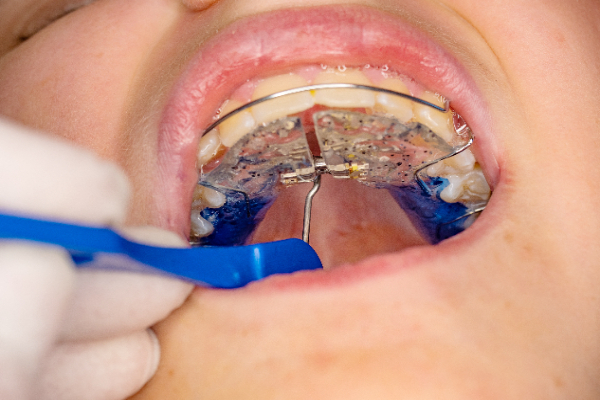How a Palatal Expander Works

A palatal expander is an oral appliance that is used to widen the upper jaw. Also known as a palate expander, these appliances fit in the roof of your mouth and gradually move the two halves of your jawbone apart by applying constant pressure on the area.
Some of the issues a dentist might recommend a palatal expander for include:
- Overlapping teeth
- Crowded teeth
- Impacted teeth
- Crooked teeth
- A misaligned bite
- Chewing issues
How a palatal expander widens your jaw
Dentists typically recommend palatal expanders to improve how a patient’s upper and lower set of teeth fit together or to create more space on the jaw for their teeth. Expanding the palate can also help to reduce the symptoms of obstructive sleep apnea.
A palatal expander can be used by children and adults alike. Dentists usually recommend getting children started with treatments around the ages of seven to eight. Children still have soft bones at this stage in their development, making it easier to widen their jaw. Getting children started with treatments this early on typically helps to avoid needing more invasive treatments in the future. Widening the jaws of teenagers and adults usually takes longer since their bones have already hardened.
Types
There are several types of palatal expanders commonly used in dentistry. Some of these appliances are removable, while others are implant-supported. Some of the palatal expanders a dentist might recommend include:
1. Removable palate expander
This appliance looks a lot like a retainer, but it is made out of chrome instead of acrylic. These removable appliances are typically recommended for patients who only need to widen their jaw a bit.
2. Rapid palate expander
These appliances fit in the roof of your mouth and are attached to the patient’s back upper teeth for extra stability. They come with small screws in the middle that are turned a little each day with a special key to increase the tension the appliance puts on the palatal bones. Over time, this pushes the two palatal bones away from each other, widening the patient’s jaw.
Rapid palate expanders are extremely effective tools that widen teeth at a rate of up to 0.5 millimeters daily. Most patients get their desired results within six months of using these devices.
3. Surgically assisted rapid palate expander
These devices are reserved for adults with moderate to severe jaw alignment or size issues. The appliance is surgically attached to the mid-palatal suture and relies on the patient’s back teeth for support. As is the case with rapid expanders, patients will need to activate the expander daily to increase the tension it puts on their palatal structures.
4. Implant-supported palate expander
These are typically used on teens and adults, and they work by applying force to four mini implants inserted into the patient’s jaw. This allows the dentist to apply pressure directly to the patient’s upper jaw. Patients might need to be referred to an oral surgeon who performs the surgical placement of the implants.
Improve your bite with palatal expanders
You might need a palatal expander if you have teeth alignment issues like overlapping, crooked, and misaligned teeth. Call or visit our Dubuque clinic to set up an appointment.
Request an appointment here: https://www.bracesbyabbadent.com or call Braces By Abbadent at (563) 484-5202 for an appointment in our Dubuque office.
Check out what others are saying about our services on Yelp: Read our Yelp reviews.
Recent Posts
If your child has extensive dental malalignment, Invisalign® for teens may not be appropriate. However, if the malalignment is relatively mild, you and your child may have the option of choosing between clear aligners and traditional braces. Comparing and contrasting the two treatments can help you decide which would most benefit your teen.There are few…
If your dentist has recommended that you get braces, you should know that they can improve your oral health. Braces are about more than simply straightening your teeth. Braces will also help you avoid cavities. Getting braces now can help you have straighter teeth later. Read on to learn how braces can do this.A dentist…
Considering Invisalign for adult teeth straightening? While most consider teeth straightening to be for children, there are a lot of adults that require a re-alignment of the teeth. Teeth can shift over time, which can result in a need for braces or better yet, Invisalign. Invisalign is a popular treatment option for teeth straightening. Ready to find out…
Curious about ceramic braces? Read on to learn more about this teeth-straightening option. Ceramic braces, sometimes known as transparent braces, have been available for decades. Although transparent aligner solutions have made them less popular, they are still a wonderful choice for people seeking reasonably discreet treatment. Ceramic braces provide patients with a less noticeable option…


